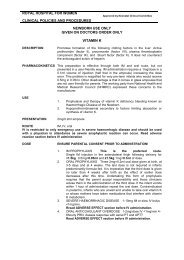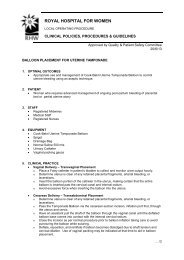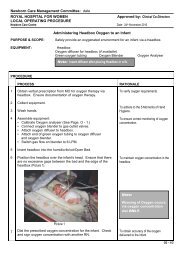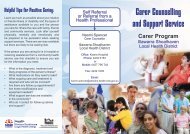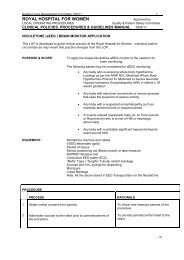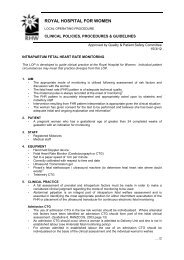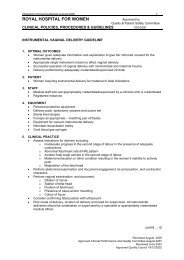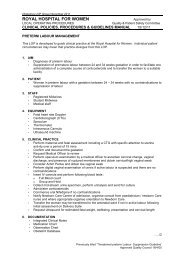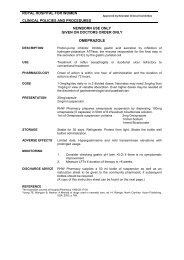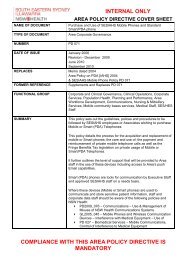ACMI - Consultation and Referral Guidelines 2009 - South Eastern ...
ACMI - Consultation and Referral Guidelines 2009 - South Eastern ...
ACMI - Consultation and Referral Guidelines 2009 - South Eastern ...
Create successful ePaper yourself
Turn your PDF publications into a flip-book with our unique Google optimized e-Paper software.
Professor Marc KeirseA/Prof Sue KildeaAnne LainchburyPaula LawsProfessor Nicky LeapKathren LingardYvonne McCannDr Michael NichollDr Anne NixonBruce TeakleJocelyn ToohillDr Mark TracyProfessor William WaltersLiz WilkesProfessor of Obstetrics & Gynaecology, Flinders University, SAAssociate Professor in Midwifery, Charles Darwin University,Darwin, NTClinical Midwifery Consultant, Royal Hospital for Women,R<strong>and</strong>wick, NSWSenior Data Analyst, AIHW National Perinatal Statistics Unit,UNSW, SydneyProfessor of Midwifery Practice Development <strong>and</strong> Research,<strong>South</strong> <strong>Eastern</strong> Sydney <strong>and</strong> Illawarra Area Health Service, NSWClinical Midwifery Consultant, RNS <strong>and</strong> Ryde Hospitals, Sydney,NSWDirector, Clinical Services, Women’s <strong>and</strong> Children’s Health, RNS,Sydney, NSWDirector of Obstetrics, Royal North Shore Hospital, NorthernSydney <strong>and</strong> Central Coast Area Health Service, NSWMidwifery Unit Head, Midwifery Group Practices, Women’s <strong>and</strong>Children’s Hospital, Adelaide, SAConsumer representative, Maternity CoalitionQueensl<strong>and</strong> representative, ACM, Queensl<strong>and</strong>Consultant Neonatologist, Sydney West Area Health Service,NSWExecutive Clinical Director, Royal Hospital for Women,R<strong>and</strong>wick, NSWProfessional Officer, Australian College of MidwivesThanks also to Therese Lahoud for taking minutes.
1. PreambleIn early 2007, the Australian College of Midwives (ACM) commissionedthe revision of the National Midwifery <strong>Guidelines</strong> for <strong>Consultation</strong> <strong>and</strong><strong>Referral</strong> (the <strong>Guidelines</strong>). First published in 2004, the <strong>Guidelines</strong> have beendeveloped based on comparable guidelines in use in other OECD countries1,2,3,4 as well as on a thorough review of current evidence based practice inmaternity care.In the first edition of the <strong>Guidelines</strong>, the College made clear its commitmentto reviewing <strong>and</strong> updating them once they had been in widespread use toensure they were clear, comprehensive <strong>and</strong> usable. Regular revision ensuresthat the <strong>Guidelines</strong> continue to reflect the latest available research evidenceon best practice.After three years of widespread use by maternity services across Australia,the first revision of these <strong>Guidelines</strong> commenced in 2007. The ACMestablished a multidisciplinary Expert Working Group <strong>and</strong> called forsubmissions from a wide range of experts—including midwives, doctors,health service managers, regulators, employers <strong>and</strong> consumers—on theevidence base, clarity <strong>and</strong> usefulness of the 2004 <strong>Guidelines</strong>. It also invitednumerous stakeholder organisations to contribute to a Reference Group toreview the recommendations of the Expert Working Group <strong>and</strong> ensure broadinput into its deliberations.When the Australian College of Midwives first published these <strong>Guidelines</strong>,it did so in an environment in which there was a lack of comprehensiveguidelines to provide an evidence-based framework for collaborationbetween midwives <strong>and</strong> doctors in the care of individual women. In particularthere was no single, nationally consistent <strong>and</strong> evidence based tool to assistmidwives to make decisions about when to discuss care with other midwives,<strong>and</strong>/or to consult with or transfer a woman’s care to a suitably qualifieddoctor. This was identified as a barrier to the successful establishment ofmidwifery services where midwives are primary care givers, offering womencontinuity of care in collaboration with other healthcare providers. These<strong>Guidelines</strong> were first developed to address this gap <strong>and</strong> the revised editioncontinues to meet the same need.However, the <strong>Guidelines</strong> are relevant not only to services <strong>and</strong> individualsoffering midwifery continuity of care. The <strong>Guidelines</strong> are intended to helpall maternity services to meet national policy priorities aimed at improvingthe quality <strong>and</strong> safety of health care. When the Australian Council for Safety
3. IntroductionThe Australian College of Midwives National Midwifery <strong>Guidelines</strong> for<strong>Consultation</strong> <strong>and</strong> <strong>Referral</strong> (the <strong>Guidelines</strong>) have been developed to assistmidwives responsible for providing care to a woman to decide when it isappropriate to discuss care of that woman with a medical or midwiferycolleague, or to refer a woman for further care <strong>and</strong>/or advice.The aim of the <strong>Guidelines</strong> is to promote a system of care based upon theprinciple of close mutual co-operation between primary, secondary ortertiary level maternity caregivers <strong>and</strong> the woman involved 1 .Primary maternity care is where the responsibility for maternity carerests with the primary level maternity care provider, in this case, themidwife.Secondary maternity care is where the responsibility for maternitycare rests with the medical practitioner such as a general practitioner,specialist obstetrician, or the medical staff on duty in the referralhospital.Tertiary maternity care is when responsibility for maternity care restswith a team of providers in a specialised hospital. This may include anobstetrician, neonatologist, midwife or other specialised services.Midwives, as primary carers, need to make decisions when a woman intheir care may need medical attention during pregnancy, labour, birth orthe post-natal period. These <strong>Guidelines</strong> have been developed to providemidwives with support in doing this in consultation with the woman to whomthe midwife is providing care. It is the intention that the <strong>Guidelines</strong> be usedto facilitate consultation <strong>and</strong> integration of care between midwives <strong>and</strong>doctors, thereby giving confidence to providers, women <strong>and</strong> their families.1 The distinction between primary, secondary <strong>and</strong> tertiary level maternity caregivers should be seen as distinct from the levels of hospital grading currentlyunder revision in Australia.10
3.2 GUIDING PRINCIPLES:Use of the <strong>Guidelines</strong>:1. As a primary caregiver, the midwife is responsible for herprofessional decision-making. These <strong>Guidelines</strong> are for the use ofthe midwife in making decisions.2. If problems occur during pregnancy or birth, the midwife mayconsult with her peers in the first instance; or consult directly witha secondary or tertiary level health care provider <strong>and</strong> refer whenappropriate.3. The midwife discusses care of a woman, consults, or refersprimary care responsibility according to the <strong>Guidelines</strong>.4. The secondary or tertiary level health care-provider may alsorefer the woman back to primary care by the midwife at anytime if the condition that prompted referral is no longer a riskfactor.5. The severity of the condition will influence these decisions.Informed Choice1. At booking, the midwife should outline the scope <strong>and</strong> boundariesof midwifery care. This will include an explanation of these<strong>Guidelines</strong> with the woman.2. Midwifery care must be provided within the principle of informedchoice. The midwife must provide the woman with sufficientinformation to inform the woman’s consent to any procedure oradvice. The woman has the right to give or refuse consent toany procedure or advice.3. When a woman’s choice is significantly at variance fromprofessional advice or guidelines, the woman’s decision <strong>and</strong>the information provided by the midwife should be carefullydocumented. In these circumstances Appendix A: “When awoman chooses care outside the recommendations of theACM <strong>Guidelines</strong>” 3 provides guidance to the midwife, <strong>and</strong> ast<strong>and</strong>ardised consent form. 43 College of Midwives of Ontario When A Client Chooses Care Outside Midwifery St<strong>and</strong>ards of Practice January 1994, Revised September 22, 20044 This Midwifery/Multi Disciplinary Care Plan was developed by the Government of <strong>South</strong> Australia <strong>and</strong> was considered by the Expert Working Group as anegotiation tool. The document demonstrates a three way sign off by the midwife, the women <strong>and</strong> other health provider if involved. The tool defines theterms of engagement <strong>and</strong> helps providers acknowledge that women have choice. This tool is a negotiated care pathway which gives fully informedparticipation in decision making to the woman.12
3.3 STRUCTURE OF THESE GUIDELINESTo optimise the quality <strong>and</strong> efficiency of the care provided, the <strong>Guidelines</strong>provide indicators to identify situations where midwives carry out riskassessment<strong>and</strong> referral decisions. For the convenience of the practitioner,the <strong>Guidelines</strong> are organised into four main sections:• Indications At Booking• Indications Developed or Discovered During Pregnancy• Indications During Labour <strong>and</strong> Birth• Indications During the Postnatal PeriodEach section contains ready-reference tables listing specific conditions orcircumstances that a woman or her baby may present with, <strong>and</strong> includesthe recommended response by the midwife in making a decision aboutappropriate care.13
4.2 CONSULTB: Consult with a medical or other health care provider.4.2. 1 A consultation refers to the situation where a midwife recommendsthe woman consult a medical practitioner, or where the womanrequests another opinion of a health care provider.4.2. 3. It is the midwife’s responsibility to initiate a consultation <strong>and</strong> toclearly communicate to the health care provider that she is seekinga consultation.4.2. 4. The consultation involves addressing the variance from normal*e.g., a ‘face to face’ assessment, the prompt communication ofthe findings <strong>and</strong> recommendations to the woman <strong>and</strong> the healthcare provider to whom referral is made.4.2. 5. Where a consultation occurs, the decision regarding ongoingclinical roles/ responsibilities must involve a three-way discussionbetween the health care provider, the midwife <strong>and</strong> the womanconcerned. This should include discussion about any need for, <strong>and</strong>timing of, medical practitioner review.4.2. 6. The midwife or health care provider will not automatically assumeresponsibility for ongoing care. This will depend on the clinicalsituation <strong>and</strong> the wishes <strong>and</strong> needs of the individual woman.4.2. 7. After consultation with a medical practitioner, it should be clearwhether primary care <strong>and</strong> responsibility:a) continues with the midwife, orb) is transferred to the medical practitioner.4.2. 8. The midwife maintains overall responsibility for midwifery care withinher scope of practice in collaboration with the medical practitioner<strong>and</strong> remains responsible for this discrete area of the woman’s care.4.2. 9. Where urgency, distance, or adverse circumstances make a ‘faceto face’ consultation impossible between a woman <strong>and</strong> a healthcare provider the midwife should seek advice by phone. Themidwife should document this request for advice in her records,<strong>and</strong> discuss with the woman the advice received.4.2. 10. Areas of discussion <strong>and</strong> involvement must be agreed upon <strong>and</strong>clearly documented.15
4.3 REFERC: Refer a woman or her infant to Secondary or Tertiary Care.4.3.1. When primary care is referred, permanently or temporarily, from themidwife to a medical practitioner, that professional, in consultationwith the woman <strong>and</strong> midwife, assumes full responsibility forsubsequent decision-making.4.3.2. When primary care is referred to a medical practitioner, the midwifemay continue to provide midwifery care within her scope ofpractice, in collaboration with the medical practitioner.4.3.3. Areas of discussion <strong>and</strong> involvement must be agreed upon <strong>and</strong>clearly documented.16
Table 4.1 Summary of Codes used for the health care providersCode Description Care providerA DiscussThe responsibility for maternity carein the situation described is with themidwife.Midwife 5B ConsultEvaluation involving both primary<strong>and</strong> secondary care needs. Theindividual situation of the woman willbe evaluated <strong>and</strong> agreements willbe made about the responsibility formaternity care.Medical/ Health carepractitioner <strong>and</strong>/ or midwife depending onagreementsC ReferThis is a situation requiring medicalcare at a secondary or tertiary levelfor as long as the situation exists.Medical practitioner (Where appropriatethe midwife continues to providemidwifery care)5 A midwife is a person who, having been regularly admitted to a midwifery education programme, duly recognised in the country in which it is located,has successfully completed the prescribed course of studies in midwifery <strong>and</strong> has acquired the requisite qualifications to be registered <strong>and</strong>/or legallylicensed to practice midwifery.The midwife is recognised as a responsible <strong>and</strong> accountable professional who works in partnership with women to give the necessary support, care <strong>and</strong>advice during pregnancy, labour <strong>and</strong> the postpartum period, to conduct births on the midwife’s own responsibility <strong>and</strong> to provide care for the newborn<strong>and</strong> infant. This care includes preventive measures, the promotion of normal birth, the detection of complications in mother <strong>and</strong> child, the accessing ofmedical or other appropriate assistance <strong>and</strong> the carrying out of emergency measures.The midwife has an important task in health counseling <strong>and</strong> education, not only for the woman, but also within the family <strong>and</strong> community. This work shouldinvolve antenatal education <strong>and</strong> preparation for parenthood <strong>and</strong> may extend to women’s health, sexual or reproductive health <strong>and</strong> childcare.A midwife may practice in any setting including the home, community, hospitals, clinics or health units.Adopted 19th July 2005 ICM Congress, Brisbane, Australia.Supersedes the ICM International Definition of the Midwife 1972 <strong>and</strong> its amendments of 1990.17
➝5. How to use these <strong>Guidelines</strong>Figure 1. A decision diagram for use by Midwives in daily practiceBookingInitial Assessment➝Uncomplicated history➝Complicated historyCare provided by midwife➝Consult <strong>Guidelines</strong>Decide A, B or C.PregnancyOngoing assessment➝➝Uncomplicated➝ComplicatedCare provided by midwife➝Consult <strong>Guidelines</strong>.Decide A, B or C.Labour & birthOngoing assessment➝➝Uncomplicated➝ComplicatedCare provided by midwife➝Consult <strong>Guidelines</strong>.Decide A, B or C.Postnatal timeOngoing assessment➝➝UncomplicatedComplicatedCare provided by midwifeConsult <strong>Guidelines</strong>.Decide A, B or C.ABC18Discuss with midwife/medical practitioner <strong>and</strong> care provided by midwife<strong>Consultation</strong> with medical practitioner <strong>and</strong> care continues with midwifeor is transferred to medical practitionerRefer care to medical practitionerWhen there is any doubt, consultation is recommended.Sources Adapted from: Obstetrical Manual. Final Report of the Obstetric Working Group of the National HealthInsurance Board of the Netherl<strong>and</strong>s. 2000; College of Midwives of Ontario, 2000. Indications for M<strong>and</strong>atoryDiscussion, <strong>Consultation</strong> <strong>and</strong> Transfer of Care 2000; NZ Ministry of Health Maternity Services. Notice Pursuant toSection 88 of the New Zeal<strong>and</strong> Public Health <strong>and</strong> Disability Act 2000. July 2002.
6. Indications at BookingThe following are specific indications for discussion, consultation <strong>and</strong>/orreferral of care when first discussing a woman’s needs during a booking visit.The main purpose of the indication list is to provide a guide for risk-selection.The Codes in the Tables for A ‘Discussion’, B ‘<strong>Consultation</strong>’ <strong>and</strong> C ‘<strong>Referral</strong> ofCare’ are explained in Part 4 of these <strong>Guidelines</strong>.6.1. Medical Conditions6.2. Pre-existing gynaecological disorders6.3 Previous Obstetric history6.1. Medical Conditions6.1.1 Anaesthetic difficulties· Previous failure or complication (e.g. difficult intubation, failed•epidural)· Malignant hyperthermia or neuromuscular disease6.1.2 Autoimmune disease B6.1.3 Cardiovascular disease / Hypertension C6.1.4 Drug dependence or misuse· Use of alcohol <strong>and</strong> other drugs· Medicine use: the effect of drugs on the pregnant woman <strong>and</strong> the•unborn child, lactation <strong>and</strong>/or neonate. Information is available•from – Mothersafe 1800 647 848BCBB6.1.5 EndocrineDiabetes mellitus· Pre-existing insulin dependent or non insulin dependent· Gestational diabetes requiring insulinThyroid disease· Hypothyroidism· HyperthyroidismAddison’s Disease; Cushing’s Disease or other endocrine disorderrequiring treatment6.1.6 Gastro-intestinal· Hepatitis B with positive serology (Hbs-AG+)· Hepatitis C· Inflammatory Bowel DiseaseThis includes ulcerative colitis <strong>and</strong> Crohn’s disease.CCBBCBBB19
... at booking6.1.7 Genetic – any condition B6.1.8 Haematological· Thrombo-embolic process . Of importance is the underlyingpathology <strong>and</strong> the presence of a positive family medical history· Coagulation disorders· Anaemia at booking irrespective of how treated or whether itresponds to treatmentAnaemia defined as Hgb < 9g/dL6.1.9 Infectious Diseases· HIV-infection· Rubella· Cytomegalovirus· Parvo virus infection· Varicella/Zoster virus infection· Herpes genitalis: primary infection· Herpes genitalis: recurrent infection· Tuberculosis: active tuberculous or a history of Tuberculosis· Syphiliso Positive serology <strong>and</strong> treatedo Positive serology <strong>and</strong> not yet treatedo Primary infection· ToxoplasmosisIf there is a history of viral ,microbial,or parasitic infections whether activeor a previous medical history then medical consultation is required.6.10 Maternal Age (under 14 <strong>and</strong> older than 45 years) A/B6.11 Maternal Weight > 100kg or Body Mass Index 35 B6.1.12 Neurological· Epilepsy, without medication or in the past without treatment <strong>and</strong>no seizures in the last 12 months· Epilepsy, with medication or seizure in the last 12 months· Subarachnoid haemorrhage, aneurysms· Multiple sclerosis· AV malformations· Myasthenia gravis· Spinal cord lesion (para or quadraplegia)· Muscular dystrophy or Myotonic DystrophyCCBCBBBBAABBBBBBB/CCBCCCC6.1.13 History of Mental Health Disorders· Care during pregnancy <strong>and</strong> birth will depend on the severity<strong>and</strong> extent of the mental health disorder.B20
... at booking6.1.14 Renal function disorders· Disorder in renal function, with or without dialysis· Urinary tract infections· Pyelitis6.1.15 Respiratory Disease· Asthma Mild· Asthma Moderate (i.e. oral steroids in the last year <strong>and</strong>maintenance therapy)· Severe Lung function disorder6.1.16 System/connective tissue diseases· These include rare maternal disorders such as systemic lupuserythematosus (SLE), anti-phospholipid syndrome (APS),scleroderma, rheumatoid arthritis, periarteritis nodosa,Marfan’s syndrome, Raynaud’s disease <strong>and</strong> other systemic<strong>and</strong> rare disorders.CBBBCCC6.2. Pre-existing gynaecological disorders6.2.1 Pelvic floor reconstruction· This refers to colpo-suspension following prolapse,fistula <strong>and</strong>/or previous rupture.6.2.2 Cervical Abnormalities· Cervical amputation· Cervical cone biopsy· Cervical surgery with or without subsequent vaginal birth· Abnormalities in cervix cytology (diagnostics, follow-up)6.2.3 Uterine Abnormalities· Myomectomy /hysterotomy· Bicornuate uterus6.2.4 Intra Uterine Contraceptive Device (IUCD) in situ B6.2.5 Infertility treatment B6.2.6 Pelvic deformities (trauma, symphysis rupture, rachitis) B6.2.7 Female Genital Circumcision BBCBA/BA/BBB/C21
... at booking6.3 Previous Obstetric history6.3.1 Active blood group incompatibility (Rh, Kell, Duffy, Kidd) C6.3.2 ABO-incompatibility B6.3.3 Hypertension in the previous pregnancy A/B6.3.4 Pre-eclampsia in the previous pregnancy B6.3.5 Eclampsia C6.3.6 Recurrent miscarriage (3 or more times) A/B6.3.7 Pre-term birth (5. A/B6.3.24 Shoulder Dystocia BACBBB22
7. Indications Developed/DiscoveredDuring PregnancyThe following are specific indications for discussion, consultation <strong>and</strong>/or referral ofcare in response to conditions or abnormalities that are identified during pregnancy.The main purpose of the indication list is to provide a guide for risk-selection.The Codes in the Tables for A Discussion, B <strong>Consultation</strong> <strong>and</strong> C <strong>Referral</strong> ofCare are explained in Part 4 of these <strong>Guidelines</strong>.7.1.1 Uncertain duration of pregnancy by amenorrhoea >20 weeks· <strong>Consultation</strong> is required when the duration of pregnancy is uncertainafter 20 weeks amenorrhoea. The primary care provider has accessto sufficient additional diagnostic tools in the first 20 weeks.B7.1.2 Laparotomy during pregnancy C7.1.3 Cervix cytology· CIN III or higher· CIN 1 & 27.1.4 Mental Health disorders (neuroses/psychoses) B7.1.5 Hyperemesis gravidarumB· <strong>Referral</strong> to secondary care is necessary for treatment of thiscondition. After recovery the pregnancy <strong>and</strong> birth can takeplace at primary care level.7.1.6 Ectopic pregnancy CCB7.1.7 Antenatal screening· Attention should be given to the presence of risk factors forcongenital abnormalities. If no abnormalities can be found, thenfurther care may take place at a primary level.A/C7.1.8 (Suspected) fetal abnormalities A/C7.1.9 Pre-term rupture of membranes (20 weeks gestation):· average SBP > 140mmHg <strong>and</strong>/or DBP >90 mmHg (after overnight rest,or after completion of a day assessment visit), without any evidenceBof multisystem dysfunction. GH resolves within 3 months postpartum.7.1.11 Preeclampsia (PE):· Development of SBP > 140mmHg <strong>and</strong>/or DBP >90 mmHgPreeclampsia usually occurs after 20 weeks gestation in women withno previous history of hypertension, cardiac or renal, plus evidence Cof other organ involvement (eg proteinuria, renal insufficiency, liverdisease, neurological problems, haematological disturbances, fetalgrowth restriction.) PE resolves within 3 months postpartum.7.1.12 Eclampsia C23
...during pregnancy7.1.13 Chronic Hypertension:· Hypertension that is present in the pre-conception period orthe first half of pregnancy. It may be essential where there isno apparent cause or secondary where the hypertension isassociated with renal, renovascular, endocrine disorder or aorticcoarctation.Diastolic pressure should be recorded as Point V Korotkoff (K5) (i.e. thepoint of disappearance of sounds)C7.1.14 Blood group incompatibility C7.1.15 Coagulation disorders B7.1.16 Recurring vaginal blood loss prior to 16 weeks A/B7.1.17 Vaginal blood loss at or after 16 weeks B7.1.18 Placental abruption C7.1.19 Size/date discrepancy:Small for dates. Large for dates.(Definition: symphysis fundal height >3cm or
...during pregnancy7.1.31 Endocrine· Diabetes mellituso Gestational diabetes requiring insulin· Thyroid diseaseo Hypothyroidismo Hyperthyroidism· Addison’s Disease; Cushing’s Disease or other endocrine disorderrequiring treatment.7.1.32 Gastroenterology· Hepatitis B with positive serology (Hbs-AG+)· Hepatitis C· Inflammatory Bowel DiseaseThis includes ulcerative colitis <strong>and</strong> Crohn’s disease.CBBCBBB7.1.33 Hernia nuclei pulposi (slipped disc) B7.1.34 Haematological· Thrombosis· Coagulation disorders· Anaemia at booking or close to term7.1.35 Infectious Diseases· HIV-infection· Rubella· Toxoplasmosis· Cytomegalovirus· Parvo virus infection· Varicella/Zoster virus infection· Tuberculosis: an active tuberculous process· Herpes genitaliso Primary infectiono If late in pregnancyo Recurrent· Syphiliso Positive serology <strong>and</strong> treatedo Positive serology <strong>and</strong> not yet treatedo Primary infectionCCBCBBBBCCBCAA/B/BB7.1.36 Renal function disorders· Urinary tract infections· Pyelitis7.1.37 Respiratory Disease· AsthmaBCA/B25
8. Indications During Labour<strong>and</strong> BirthThe following are specific indications for discussion, consultation <strong>and</strong>/orreferral of care in response to conditions or abnormalities that are identifiedduring labour <strong>and</strong> birth. The main purpose of the indication list is to provide aguide for risk-selection.The Codes in the Tables for A ‘Discussion’, B ‘<strong>Consultation</strong>’ <strong>and</strong> C ‘<strong>Referral</strong> ofCare’ are explained in Part 4 of these <strong>Guidelines</strong>.8.1.1 Gestational hypertension (GH) C8.1.2 Preterm labour < 37 weeks C8.1.3 Preterm pre-labour rupture of membranes (PROM) before 37weeks C8.1.4 Prolonged rupture of membranes (PROM) >18 hours B8.1.5 Abnormal presentation C8.1.6 Breech Presentation C8.1.7 Meconium stained liquor A/C8.1.8 Suspected placenta abruption <strong>and</strong>/or praevia C8.1.9 Pre-eclampsia C8.1.10 Pyrexia C8.1.11 Active genital herpes in late pregnancy or at onset of labour C8.1.12 Multiple pregnancy C8.1.13 Confirmed non-reassuring fetal heart patterns C8.1.14 Prolonged active phase B8.1.15 Prolonged second stage B8.1.16 Unengaged head in active labour in primipara B8.1.17 Prolapsed cord or cord presentation C8.1.18 Vasa praevia C8.1.19 Shoulder dystocia C8.1.20 Uterine rupture C8.1.21 Third or fourth degree perineal tear C8.1.22 Retained placenta B8.1.23 Uterine inversion C8.1.24 Post partum haemorrhage >1000mls C8.1.25 Fetal death during labour C8.1.26 Shock /Maternal Collapse C26
9. Indications During Post-partumPeriodThe following are specific indications for discussion, consultation <strong>and</strong>/orreferral of care in response to conditions or abnormalities that are identifiedin the mother or baby in the early weeks after the birth. The main purpose ofthe indication list is to provide a guide for risk-selection.The Codes in the Tables for A Discussion, B <strong>Consultation</strong> <strong>and</strong> C <strong>Referral</strong> ofCare are explained in Part 4 of these <strong>Guidelines</strong>.9.1 Indications: Postpartum (Maternal)9.1.1 Suspected maternal infectione.g. breast, abdomen, wound, uterine, urinary tract, perineum9.1.2 Temperature over 38C on more than one occasion B9.1.3 Persistent hypertension B9.1.4 Serious psychological disturbance B9.1.5 Haemorrhage > 1000mls C9.1.6 Postpartum eclampsia C9.1.7 Thrombophlebitis or thromboembolism C9.1.8 Uterine prolapse C9.1.9 Significant social isolation <strong>and</strong> lack of social support B9.2 Indications: Postpartum (Infant)9.2.1 Apgar less than 7 at 5 minutes C9.2.2 < 37 weeks gestational age B9.2.3 Infant less than 2500 g B9.2.4 Less than 3 vessels in umbilical cord B9.2.5 Excessive moulding <strong>and</strong> cephalhaematoma B9.2.6 Abnormal findings on physical examination B9.2.7 Excessive bruising, abrasions, unusual pigmentation <strong>and</strong>/or lesions C9.2.8 Birth injury requiring investigation B9.2.9 Birth trauma B9.2.10Congenital abnormalities, for example: cleft lip or palate, congenitaldislocation of hip, ambiguous genitaliaC9.2.11 Major congenital anomaly requiring immediate intervention, for Cexample: omphalocele, myelomeningocele9.2.12 Abnormal heart rate or pattern B9.2.13 Abnormal cry B9.2.14 Persistent abnormal respiratory rate <strong>and</strong>/or pattern BB27
...during post-partum9.2.15 Persistent cyanosis or pallor B9.2.16 Jaundice in first 24 hours B9.2.17 Suspected pathological jaundice after 24 hours B9.2.18 Temperature instability C9.2.19 Temperature less than 36° C, unresponsive to therapy B9.2.20Temperature more than 37.4° C, axillary, unresponsive to nonpharmaceuticaltherapy9.2.21 Vomiting or diarrhoea C9.2.22 Infection of umbilical stump site B9.2.23 Feeding problems A/C9.2.24 Significant weight loss in the first week (usually more than 10% ofbody weight)Failure to regain birth weight in three weeks9.2.25 Failure to thrive B9.2.26 Failure to pass urine or meconium within 24 hours of birth A/B9.2.27 Failure to pass urine or meconium within 36 hours of birth B9.2.28 Suspected clinical dehydration B9.2.29 Suspected seizure activity CCBB28
10. Review of these <strong>Guidelines</strong>It is the intention of the Australian College of Midwives to continue toupdate <strong>and</strong> republish these <strong>Guidelines</strong> at timely intervals. Organisations <strong>and</strong>individuals are invited to send any comments on these guidelines to:Post:Email:Australian College of MidwivesPO Box 87 Deakin West,ACT 2600, Australia orexecutiveofficer@midwives.org.au29
11. BibliographyAlbers LL. 2001. Monitoring the fetus in labor: evidence to support themethods. J Midwifery Womens Health. Nov-Dec; 46(6): 366-73. ReviewAlbers LL, Sedler KD, Bedrick EJ, Teaf D, Peralta P. 2006. Factors relatedto genital tract trauma in normal spontaneous vaginal births Birth.33(2):94-100.Althuisius SM, Dekker GA, Hummel P, et al. 2001. Final results of the CervicalIncompetence Prevention R<strong>and</strong>omised Cerclage Trial (CIPRACT):therapeutic cerclage with bed rest versus bed rest alone. Am JObstetGynecol. 185:1106 –1112.AMAP.2003. Barclay L, Brodie P, Lane K, Leap N, Reiger K, Tracy S (2003) TheFinal Report of The Australian Midwifery Action Project, (AMAP) Centrefor Family Health <strong>and</strong> Midwifery, UTS, Sydney.American Public Health Association, Inc. 2001. Supporting Access toMidwifery Services in the United States (Position Paper) AmericanJournal of Public Health. 91(3): 482-485.Anim-Somuah M, Smyth R, Howell C. 2005. Epidural versus non-epidural or noanalgesia in labour. Cochrane Database of Systematic Reviews 2005,Issue 3. Art. No.: CD000331. DOI: 10.1002/14651858.CD000331.pub2(accessed 28 th August 2008)Audit Commission. 1997. First class delivery: improving maternity services inEngl<strong>and</strong> <strong>and</strong> Wales. London: Audit Commission Publications.Australian Council for Safety <strong>and</strong> Quality in Health Care. 2000.NationalAction Plan 2001.Bauer K, Cowett RM, Howard GM, et al. 1993. Effect of intrauterine growthretardation on postnatal weight change in preterm infants. J Pediatr.123(2): 301-6.Beckmann MM, Garrett AJ. 2006. Antenatal perineal massage for reducingperineal trauma. Cochrane Database of Systematic Reviews 2006,Issue 1. Art. No.: CD005123. DOI: 10.1002/14651858.CD005123.pub2(accessed 28 th August 2008)Benjamin Y, Walsh D, Taub N. 2001. A comparison of partnership caseloadmidwifery care with conventional team midwifery care: labour <strong>and</strong>birth outcomes. 2001. Midwifery. 17: 234-240.Biro M, Waldenstrom U, Pannifex J H. 2000. Team Midwifery Care in a TertiaryLevel Obstetric Service: A R<strong>and</strong>omized Controlled Trial. Birth. Issues inPerinatal Care. 27(3):168-173.30
Blondel B, Breart G, Glado J, et al. 1990. Evaluation of the home-visiting systemfor women with threatened preterm labour. Results of a r<strong>and</strong>omisedcontrolled trial. Eur J Obstet Gynaecol Reprod Biol. 34: 47–58.Boer K, Smit BJ, van Huis AM, et al. 1994. Substance use in pregnancy: do wecare? Acta Paediatr Suppl. 404: 65-71.Brown MA, de Swiet M. 1999. Classification of hypertension in pregnancy.Best Practice & Research in Clinical Obstet.Gynaecol. 13: 27-39.Buckley S. 2007. Gentle Birth, Gentle Mothering. http://www.sarahjbuckley.com/ (accessed 29th August 2008)Campbell R, MacFarlane A. 1994. 2nd ed. Where to be Born? The Debate<strong>and</strong> the Evidence. National Perinatal Epidemiology Unit, Oxford.Carroli G, Belizan J. 1999. Episiotomy for vaginal birth. Cochrane Databaseof Systematic Reviews 1999, Issue 2. Art. No.: CD000081. DOI:10.1002/14651858.CD000081 (accessed 28th August 2008)Catalano PM. 2007. Management of obesity in pregnancy. Obstet Gynecol.109(2 Pt 1): 419-33.Chaillet N, Dumont A. 2007. Evidence-Based Strategies for ReducingCesarean Section Rates: A Meta-Analysis Birth. 34 (1): 53-64Chasnoff IJ, McGourty RF, Bailey GW, Hutchins E, Lightfoot SO, Pawson LL,Fahey C, May B, Brodie P, McCulley L, Campbell J. 2005. The 4P’sPlus screen for substance use in pregnancy: clinical application <strong>and</strong>outcomes. Journal of Perinatology. 25: 368–374.Cnattingius S, Forman MR, Berendes HW, et al. 1992. Delayed childbearing<strong>and</strong> risk of adverse perinatal outcome. A population-based study.JAMA. 268(7): 886-90.College of Midwives of Ontario. 2000. Indications for M<strong>and</strong>atory Discussion,<strong>Consultation</strong> <strong>and</strong> <strong>Referral</strong> of Care.Cook RJ, Dickens BM, Fathalla MF. 2002. Female genital cutting (mutilation/circumcision): ethical <strong>and</strong> legal dimensions. Int J Gynaecol Obstet.79: 281-7Creasy RK. 1993. Preterm birth prevention : Where are we? Am J ObstetGynecol .168: 1223–1230.Creedy, DK, Shochet, IM, Horsfall J, 2000. Childbirth <strong>and</strong> the development ofacute trauma symptoms: incidence <strong>and</strong> contributing factors. Birth 27:104–111.Crowther CA, Harding JE. 2007. Repeat doses of prenatal corticosteroidsfor women at risk of preterm birth for preventing neonatal respiratorydisease. Cochrane Database of Systematic Reviews 2007, Issue 2. Art.No.: CD003935. DOI: 10.1002/14651858.CD003935.pub2 (accessed 28thAugust 2008)31
Dahlen HG, Homer CS, Cooke M, Upton AM, Nunn R, Brodrick B. 2007.Perineal outcomes <strong>and</strong> maternal comfort related to the applicationof perineal warm packs in the second stage of labor: a r<strong>and</strong>omisedcontrolled trial. Birth. 34(4): 282-90.Davey DA, MacGillivray I. 1988. The classification <strong>and</strong> definition of thehypertensive disorders of pregnancy. Am J Obstet Gynecol.158(4): 892-8.Definitions, evaluation <strong>and</strong> classification of hypertensive disorders inpregnancy. 1997. Canadian Medical Association Journal. 157:715-25.Department of Women’s Health, Family <strong>and</strong> Community Health, World HealthOrganization. 2000. A systematic review of the health complications offemale genital mutilation including sequelae in childbirth WHO/FCH/WMH/00.2, World Health Organization, Geneva.Drugan A, Johnson MP, Reichler A, et al. 1996. Second-trimester minorultrasound anomalies: impact on the risk of aneuploidy associated withadvanced maternal age. Obstet Gynecol. 88(2): 203-6.Earl-Slater A. 2002. The H<strong>and</strong>book of Clinical Trials <strong>and</strong> Other Research.Radcliffe Medical Press: Abingdon UK.Edge V, Laros RKJr. Pregnancy outcome in nulliparous women aged 35 orolder. 1993. Am J Obstet Gynecol. 168(6 Pt 1): 1881-4.Edwards, NP. (2005). Birthing Autonomy: Women’s Experiences Of PlanningHome Births: Routledge: Oxford.Enkin M, Keirse MJNC, Neilson J, Crowther C, Duley L, Hodnett E, Hofmeyr J, AGuide to Effective Care in Pregnancy <strong>and</strong> Childbirth. 3rd Ed. OUP: Oxford.http://www.childbirthconnection.org (accessed 29th August 2008)Flint C, Poulengeris P. 1989. The ‘Know Your Midwife’ scheme - a r<strong>and</strong>omizedtrial of continuity of care by a team of midwives. Midwifery. 5:11-16Fretts RC, Schmittdiel J, McLean FH, et al. 1995. Increased maternal age <strong>and</strong>the risk of fetal death. N Engl J Med. 333(15): 953-7Gamble JA, Creedy DK, Moyle W, Webster J, McAllister M, Dickson P. 2007.Effectiveness of a counselling intervention after a traumatic childbirth:a r<strong>and</strong>omized controlled trial. Birth 32(1): 11-19Gamble JA, Creedy DK. 2001. Women’s preference for a cesarean section:incidence <strong>and</strong> associated factors. Birth. 28: 101-110Gordon B, Mackrodt C, Fern E, et al. 1998. The Ipswich Childbirth Study: 1.A r<strong>and</strong>omised evaluation of two stage postpartum perineal repairleaving the skin unsutured. Br J Obstet Gynaecol. 105:435–440.Gottvall K, Waldenstrom U. 2002. “Does a traumatic birth experience have animpact on future reproduction?” BJOG. 109:254-60Graafmans WC, Richardus J-H, Macfarlane A, Rebagliato M, Blondel B,Verloove-Vanhorick SP, Mackenbach JP. 2003. Comparability of32
published perinatal mortality rates in Western Europe: the quantitativeimpact of differences in gestational age <strong>and</strong> birthweight criteria. Br JObstet Gynaecol. 108 (12): 1237- 1245.Grant A, Gordon B, Mackrodt C, et al. 2001. The Ipswich childbirth study:one year follow up of alternative methods used in perineal repair. Br JObstet Gynaecol. 108: 34–40.Grant A, Penn ZJ, Steer PJ. 1996. Elective or selective caesarean delivery ofthe small baby? A systematic review of the controlled trials. Br J ObstetGynaecol. 103:1197–1200.Grimshaw JM, Russell IT, 1993. Effect of clinical guidelines on medicalpractice: a systematic review of rigorous evaluations. Lancet. 342:1317- 1322Grol R, Grimshaw J. 2003. From best evidence to best practice: effectiveimplementation of change in patients’ care. Lancet. 362(9391):1225-30.Guillil<strong>and</strong> K, Pairman S. 2001. The Midwifery Partnership: A model for practice.Department of Nursing <strong>and</strong> Midwifery Monograph Series 95/1. VictoriaUniversity of Wellington, NZ,Gupta JK, Hofmeyr GJ, Smyth R. Position in the second stage of labourfor women without epidural anaesthesia. Cochrane Databaseof Systematic Reviews 2003, Issue 2. Art. No.: CD002006. DOI:10.1002/14651858.CD002006.pub2 (accessed 28th August 2008)Gyetvai K, Hannah ME, Hodnett ED, et al. 1999. Tocolytics for preterm labor: Asystematic review. Obstet Gynecol. 94: 869–877.Hannah ME, Hannah WJ, Hewson SA, Hodnett ED, Saigal S, Willan AR. 2000.Planned caesarean section versus planned vaginal birth for breechpresentation at term: a r<strong>and</strong>omised multicentre trial. Lancet. 356: 1375–1383.Hansen SL, Clark SL, Foster JC. 2002. Active pushing versus passive fetaldescent in the second stage of labor: a r<strong>and</strong>omized controlled trial.Obstet Gynecol. 99: 29–34.Harvey S, Jarrell J, Brant R, et al. 1996. A r<strong>and</strong>omized controlled trial of nursemidwifery care. Birth. 23(3): 128-135Henderson J, McC<strong>and</strong>lish R, Kumiega L, Petrou S. 2001. Systematic review ofeconomic aspects of alternative models of delivery. BJOG. 108 (2):149-57Hodnett ED, Gates S, Hofmeyr GJ, Sakala C. 2007. Continuous support forwomen during childbirth. Cochrane Database of Systematic Reviews2007, Issue 2. Art. No.: CD003766. DOI: 10.1002/14651858.CD003766.pub2 (accessed 28th August 2008)Hodnett ED, Downe S, Edwards N, Walsh D. 2004. Home-like versusconventional institutional settings for birth. Cochrane Databaseof Systematic Reviews 2004, Issue 4. Art. No.: CD000012. DOI:10.1002/14651858.CD000012.pub2 (accessed 28th August 2008)33
Hodnett ED, Fredericks S. 2003. Support during pregnancy for womenat increased risk of low birthweight babies. Cochrane Databaseof Systematic Reviews 2003, Issue 2. Art. No.: CD000198. DOI:10.1002/14651858.CD000198 (accessed 28th August 2008)Hofmeyr GJ, Kulier R. 1996. External cephalic version for breech presentation atterm. Cochrane Database of Systematic Reviews 1996, Issue 2. Art. No.:CD000083. DOI: 10.1002/14651858.CD000083 (accessed 28th August 2008)Hofmeyr GJ. 1998. Amnioinfusion for preterm rupture of membranes. CochraneDatabase of Systematic Reviews 1998, Issue 1. Art. No.: CD000942. DOI:10.1002/14651858.CD000942 (accessed 28th August 2008)Hofmeyr GJ, Gyte G. 2008. Interventions to help external cephalic versionfor breech presentation at term. Cochrane Database of SystematicReviews 2003, Issue 3. Art. No.: CD000184. DOI: 10.1002/14651858.CD000184.pub2 (accessed 28th August 2008)Hofmeyer GJ, Duley L, Atallah A. 2007. Dietary calcium supplementationfor prevention of pre-eclampsia <strong>and</strong> related problems: a systematicreview <strong>and</strong> commentary. BJOG. 114(8):933-43.Homer C, Brodie P, Leap N. 2008. Midwifery Continuity of Care: A PracticalGuide. Sydney: Elsevier.Homer C, Davis G, Brodie P, Sheehan A, Barclay L, Wills J, Chapman G.2001. Collaboration in maternity care: a r<strong>and</strong>omised controlled trialcomparing community-based continuity of care with st<strong>and</strong>ard hospitalcare. BJOG.108:16-22Homer C, Matha D, Jordan L, Wills J, Davis G. 2001. Community-basedcontinuity of midwifery care versus st<strong>and</strong>ard hospital care: a costanalysis. Australian Health Review. 24(1): 85-93.Hordnes K, Bergsjo P. Severe lacerations after childbirth. 1993. Acta ObstetGynecol Sc<strong>and</strong> .72(6): 413-22.House of Commons Health Committee. 2003. Choice in Maternity Services.Ninth Report of Session 2002-2003. http://www.publications.parliament.uk/pa/cm200203/cmselect/cmhealth/796/796.pdf (accessed 29thAugust 2008)Howell CJ, Chalmers I. 1992. A review of prospectively controlledcomparisons of epidural with non-epidural forms of pain relief duringlabour. Int J Obstet Anaesth. 1: 93–110.Hueston WJ, Rudy MA 1993. Comparison of labour <strong>and</strong> deliverymanagement between nurse midwives <strong>and</strong> family physicians. The J ofFamily Practice. 37(5): 449-453Isaacs JD, Magann EF, Martin RW, et al. 1994. Obstetric challenges of massiveobesity complicating pregnancy. J Perinatol. 14(1): 10-4.Johanson RB, Menon V. 1998. Vacuum extraction versus forceps for assisted34
vaginal delivery. Cochrane Database of Systematic Reviews 1998, Issue4. Art. No.: CD000224. DOI: 10.1002/14651858.CD000224 (accessed 28thAugust 2008)Kalache A, Maguire A, Thompson SG. 1993. Age at last full-term pregnancy<strong>and</strong> risk of breast cancer. Lancet. 341(8836): 33-6.Keirse MJNC, Rush RW, Anderson AB, et al. 1978. Risk of preterm delivery inpatients with previous pre-term delivery <strong>and</strong>/or abortion. Br J ObstetGynaecol. 85: 81–85.Kenny, P. Brodie, P Eckermann,S. Hall, J. 1994. Westmead Hospital TeamMidwifery Project Evaluation. Final Report. Westmead: Centre for HealthEconomics Research <strong>and</strong> Evaluation.Kenyon S, Boulvain M, Neilson JP. 2004. Antibiotics for preterm rupture ofmembranes. Cochrane Database of Systematic Reviews 2004, Issue 3.Art. No.: CD001058. DOI:10.1002/14651858.CD001058 (accessed 28thAugust 2008)Kenyon SL, Taylor DJ, Tarnow-Mordi W. 2001. Broad-spectrum antibioticsfor preterm, prelabour rupture of fetal membranes: the ORACLE Ir<strong>and</strong>omised trial. Lancet. 357: 979–988.Kenyon SL, Taylor DJ, Tarnow-Mordi W. 2001. Broad-spectrum antibiotics forspontaneous preterm labour: the ORACLE II r<strong>and</strong>omised trial. Lancet357: 989–994.Kettle C, Johanson RB. Absorbable synthetic versus catgut suture material forperineal repair. Cochrane Database of Systematic Reviews 1999, Issue3. Art. No.: CD000006. DOI: 10.1002/14651858.CD000006 (accessed 28thAugust 2008)Kettle C, Hills RK, Jones P, Darby L, Gray R, Johanson R. 2002. Continuousversus interrupted perineal repair with st<strong>and</strong>ard or rapidly absorbedsutures after spontaneous vaginal birth: a r<strong>and</strong>omised controlled trial.Lancet. 359(9325):2217-23Kettle C, Hills RK, Ismail KMK. 2007. Continuous versus interrupted sutures forrepair of episiotomy or second degree tears. Cochrane Databaseof Systematic Reviews 2007, Issue 3. Art. No.: CD000947. DOI:10.1002/14651858.CD000947.pub2 (accessed 28th August 2008)Kildea S. 1999. And the women said…..reporting on birthing services forAboriginal women from remote Top End Communities. Women’s HealthStrategy Unit, Territory Health Services, Govt Print NT.King J, Flenady V. 2002. Prophylactic antibiotics for inhibiting preterm labourwith intact membranes. Cochrane Database of Systematic Reviews2002, Issue 3. Art. No.: CD000246. DOI: 10.1002/14651858.CD000246(accessed 28th August 2008)King JF, Flenady VJ, Papatsonis DNM, Dekker GA, Carbonne B. 2002.35
36Calcium channel blockers for inhibiting preterm labour. CochraneDatabase of Systematic Reviews 2002, Issue 3. Art. No.: CD002255. DOI:10.1002/14651858.CD002255 (accessed 28th August 2008)Kirkham M. 2003. Birth Centres: A Social Model for Maternity Care. London:Elsevier Science.Kirkham M. 2000. The Midwife /Mother Relationship. London. Macmillan.Kitzinger S. 1980. Birth at Home. Oxford: Oxford University Press.Kitzinger S, Simkin P. 1984. Episiotomy <strong>and</strong> the Second Stage of Labour 2ndEd. Seattle: PennypressKlein MC, Gauthier MD, Robbins JM, et al. 1994. Relationship of episiotomyto perineal trauma <strong>and</strong> morbidity, sexual function, <strong>and</strong> pelvic floorrelaxation. Am J Obstet Gynecol. 17: 591–598.Knuist M, Bonsel GJ, Zondervan HA, Treffers PE. 1998. Low sodium diet<strong>and</strong> pregnancy-induced hypertension: a multi-centre r<strong>and</strong>omisedcontrolled trial. Br J Obstet Gynaecol. 105(4):430-4.Knuist M, Bonsel GJ, Zondervan HA, Treffers PE. 1998. Intensification of fetal<strong>and</strong> maternal surveillance in pregnant women with hypertensivedisorders. Int J Gynaecol Obstet. 61(2): 127-33Knuist M, Bonsel GJ, Zondervan HA, Treffers PE. 1998. Risk factors forpreeclampsia in nulliparous women in distinct ethnic groups: aprospective cohort study. Obstet Gynecol. 92(2):174-8Kristensen J, Vestergaard M, Wisborg K, Kesmodel U, Secher NJ. 2005. Prepregnancyweight <strong>and</strong> the risk of stillbirth <strong>and</strong> neonatal death BJOG: AnInternational Journal of Obstetrics <strong>and</strong> Gynaecology 112 (4), 403–408.Kumbi S, Isehak A. 1999. Obstetric outcome of teenage pregnancy innorthwestern Ethiopia. East Afr Med J. 76:138–140.Langer A, Villar J, Romero M, et al. 2002. Are women <strong>and</strong> providers satisfiedwith antenatal care? Views on a st<strong>and</strong>ard <strong>and</strong> a simplified, evidencebasedmodel of care in four developing countries. BMC Women’sHealth. 2(1): 7. http:// www.ncbi.nim.nih.gov/pubmed/12133195(accessed 29th August 2008)Langer O, Langer N. 1993. Diabetes in women older than 40 years of age. Social<strong>and</strong> medical aspects. Obstet Gynecol Clin North Am. 20(2): 299-311.Lansac J. 1995. Delayed parenting. Is delayed childbearing a good thing?Hum Reprod. 10(5): 1033-5.Lauzon L, Hodnett E. 2001. Labour assessment programs to delay admission tolabour wards. Cochrane Database of Systematic Reviews 2001, Issue 1.Art. No.: CD000936. DOI: 10.1002/14651858.CD000936 (accessed 28thAugust 2008)Lauzon L, Hodnett ED. 2007. Antenatal education for self-diagnosis of theonset of active labour at term. Cochrane Database of Systematic
Reviews 2007, Issue 4. Art. No.: CD000935. DOI: 10.1002/14651858.CD000935 (accessed 28th August 2008)Levine RU, Berkowitz KM. 1993. Conservative management <strong>and</strong> pregnancyoutcome in diethylstilbestrol-exposed women with <strong>and</strong> without grossgenital tract abnormalities. Am J Obstet Gynecol.169(5): 1125-9.Lopez Bernal A. 2007. Overview. Preterm labour BMC Pregnancy <strong>and</strong>Childbirth 2007, 7(Suppl 1):S2Luke B, Brown MB. : 2007. Elevated risks of pregnancy complications <strong>and</strong>adverse outcomes with increasing maternal age. Hum Reprod.22(5):1264-72Lundquist M, Olsson A, Nissen E, et al. 2000. Is it necessary to suture alllacerations after a vaginal delivery? Birth. 27: 79–85.MacDorman M, Singh G. 1998. Midwifery care, social <strong>and</strong> medical risk factors<strong>and</strong> birth outcomes in the USA. Journal of Epidemiology & CommunityHealth. 52(5): 310-317.MacGillivray I. Pre-eclamsia. The hypertensive disease of pregnancy. 1983.London: W.B. Saunders.Mancuso A, D’Anna R, Leonardi R. Pregnancy in the obese patient. 1991. EurJ Obstet Gynecol Reprod Biol. 39(2): 83-6.Marang-van de Mheen, PJ, Gunning-Schepers, Louise J. 1998. Variationbetween Studies in Reported Relative Risks Associated withHypertension: Time Trends <strong>and</strong> Other Explanatory Variables. AmericanJournal of Public Health 88(4): 618-622McC<strong>and</strong>lish R, Bowler U, van Asten H, et al. 1998. A r<strong>and</strong>omised controlledtrial of care of the perineum during second stage of normal labour. Br JObstet Gynaecol.105:1262–1272McCourt C, Weaver J, Statham H, Beake S, Gamble J, Creedy D 2007.Elective cesarean section <strong>and</strong> decision making: a critical review of theliterature. Birth. 34(1):65-79.McCourt, C, Page, L. 1996. Report on the Evaluation of One-to-OneMidwifery Practice Wolfson School of Health Sciences, Thames ValleyUniversity, London.Moore ML, Meis PJ, Ernest JM, et al. 1998. A r<strong>and</strong>omized trial of nurseintervention to reduce preterm <strong>and</strong> low birth weight births. ObstetGynecol. 91:656–661.Morrison JJ, Rennie JM. 1997. Clinical, scientific <strong>and</strong> ethical aspects of fetal<strong>and</strong> neonatal care at extremely preterm periods of gestation. Br JObstet Gynaecol.104: 1341–1350.NHMRC National Health & Medical Research Council 1996. Options forEffective Care in Childbirth Australian Government Printing Service,Canberra.37
NICE 2008. Antenatal care: Routine care for the healthy pregnant womanNational Institute for Clinical Excellence, London. http://www.nice.org.uk/pdf/ CG6 (accessed 29th August 2008)NICE 2003 Caesarean Section Guideline Evidence Tables secondconsultation. National Institute for Clinical Excellence, London. http://www.nice.org.uk/nicemedia/pdf/CSguideline_Evidencetables_2ndconsultation_draft.pdf (accessed 29th August 2008)NHMRC National Health & Medical Research Council. 1998. Review ofServices Offered by Midwives Australian Government Printing Service,Canberra.North Staffordshire Changing Childbirth Research Team. 2000. A r<strong>and</strong>omisedstudy of midwifery caseload care <strong>and</strong> traditional ‘shared care’.Midwifery. 16(4): 295-302.NSW Department of Health 1989. Maternity Services in New <strong>South</strong> Wales. FinalReport of the Ministerial Taskforce on Obstetric Services in New <strong>South</strong>Wales. Sydney: Department of Health Publication No: (HSU) 89-007.NSW Health. 2000. NSW Framework for Maternity Services: providing structure<strong>and</strong> direction for the future development of maternity service.NZ Ministry of Health Maternity Services. 2002. Notice Pursuant to Section 88of the New Zeal<strong>and</strong> Public health <strong>and</strong> Disability Act.Obstetric Manual. National Health Insurance Board of the Netherl<strong>and</strong>s 1998,Obstetric Manual: Final Report of the Obstetric Working Group of theObstetric Working Group of the (abridged version) Amstelveen.O’Reilly Green C, Cohen WR. Pregnancy in women aged 40 <strong>and</strong> older.Obstet Gynecol Clin North Am 1993; 20(2): 313-31.Ong KK, Ahmed ML, Emmett PM, Preece MA, Dunger DB. 2000. Associationbetween postnatal catch-up growth <strong>and</strong> obesity in childhood:prospective cohort study. BMJ. 320(7240):967-71.Ovelese Y, Scorza WE, Mastrlia r, Smulian JC. 2007. Postpartum hemorrhage.Obstet Gynecol Clin North Am. 34(3):421-41,Page L, McC<strong>and</strong>lish R. 2006. The New Midwifery: Science <strong>and</strong> Sensitivity inPractice 2 nd Edition. London: Churchill Livingstone.Page L, McCourt C, Beake S, Hewison J. 1999. Clinical interventions <strong>and</strong>outcomes of ‘one-to-one’ midwifery practice. J of Public HealthMedicine. 21(3): 243-248.Palo P, Erkkola R. 1993. Risk factors <strong>and</strong> deliveries associated with preterm,severely small for gestational age fetuses. Am J Perinatol. 10(1): 88-91.Peipert JF, Bracken MB. 1993. Maternal age: an independent risk factor forcesarean delivery. Obstet Gynecol .81(2): 200-5.Phillips OP, Cromwell S, Rivas M, et al. 1995. Trisomy 21 <strong>and</strong> maternal age of38
menopause: does reproductive age rather than chronological ageinfluence risk of non disjunction? Hum Genet. 95(1): 117-8.Prysak M, Lorenz RP, Kisly A. 1995. Pregnancy outcome in nulliparous women35 years <strong>and</strong> older. Obstet Gynecol. 85(1): 65-70.Ramsay LE, Williams B, Johnston GD, MacGregor GA, Poston L, Potter JF,Poulter NR, Russell, G. 1999. British Hypertension Society guidelines forhypertension management 1999: summary. BMJ.319: 630-635Ranta P, Jouppila P, Spalding M, et al. 1995. The effect of maternal obesity onlabour <strong>and</strong> labour pain. Anaesthesia. 50(4): 322-6.Raymond EG, Cnattingius S, Kiely JL. 1994. Effects of maternal age, parity,<strong>and</strong> smoking on the risk of stillbirth. Br J Obstet Gynaecol. 101(4): 301-6.Read AW, Stanley FJ. 1993. Small-for-gestational-age term birth: thecontribution of socio¬economic, behavioural <strong>and</strong> biological factors torecurrence. Paediatr Perinat Epidemiol. 7(2): 177-94.Renfrew MJ, Hannah W, Albers L, et al. 1998. Practices that minimize traumato the genital tract in childbirth: a systematic review of the literature.Birth. 25:143–160.Roberts CL, Algert C, Peat B, Tracy S, Douglas I, 2002. Trends in labour <strong>and</strong>birth interventions among low-risk women in an Australian population.ANZJOG. 42(2): 176-181.Roberts CL, Tracy S, Peat B. 2000. Rates for obstetric intervention amongprivate <strong>and</strong> public patients in Australia: population based descriptivestudy. BMJ. 321(7254): 137-141.Rosso P, Salas SP. 1994. Mechanisms of fetal growth retardation in theunderweight mother. Adv Exp Med Biol. 352: 1-9.Rowley, M, Hensley, M, Brinsmead, M, Wlodarczyk, J. 1995. Continuity of careby a midwife team versus routine care during pregnancy <strong>and</strong> birth: ar<strong>and</strong>omised trial. The Medical Journal of Australia. 163 (9): 289-293.Rush RW, Keirse MJNC, Howat P, et al. 1976. Contribution of preterm deliveryto perinatal mortality. BMJ. 2:965–968.Rust OA, Atlas RO, Reed J, et al. 2001. Revisiting the short cervix detected bytransvaginal ultrasound in the second trimester: Why cerclage therapymay not help. Am J Obstet Gynecol. 185:1098–1105.S<strong>and</strong>all J; Davies J; Warwick C. 2001. Evaluation of the Albany MidwiferyPractice: Final Report. Florence Nightingale School of Nursing <strong>and</strong>Midwifery, Kings College London..Schytt E, Lindmark G, Waldenström U. 2005. Physical symptoms afterchildbirth: prevalence <strong>and</strong> associations with self-rated health BJOG.112 (2): 210–217Senate Community Affairs Reference Committee. 1999. Rocking the Cradle:39
40a report of childbirth procedures. Canberra. Commonwealth ofAustralia. 1999Seubert DE, Huang WM, Wasserman-Hoff R. 2007. Medical legal issues in theprevention of prematurity. Clin Perinatol. 34(2):309-18.Shiono P, Klebanof MD, Carey JC. Midline episiotomies: more harm thangood? Obstet Gynaecol 1990; 75:756–770.Shorten A, Shorten B Episiotomy in NSW hospitals 1993-1996: Towardsunderst<strong>and</strong>ing variations between public <strong>and</strong> private hospitalsAustralian Health Review. 1999; 22(1): 19-32.Sibai BM. The HELLP syndrome (hemolysis, elevated liver enzymes, <strong>and</strong> lowplatelets): much ado about nothing? Am J Obstet Gynecol 1990;162(2): 311-6.Sikorski J, Renfrew M. (2000) Support for breastfeeding mothers In: TheCochrane Library. Issue 4 Oxford 2000.Simhan HN, Caritis SN. Prevention of preterm delivery. N Engl J Med2007;357:477-487Simkin P 1991. Just another day in a woman’s life? Women’s long-termperceptions of their first birth experience. Birth. 18(4): 203-10.Sleep J, Grant A, Garcia J, et al. 1984. West Berkshire perineal managementtrial. BMJ. 298:587–690.Smit Y, Scherjon SA, Knuist M, Treffers PE. 1998. Obstetric outcome of elderlylow-risk nulliparae. Int J Gynaecol Obstet. 63(1):7-14.Smit BJ, Boer K, van Huis AM, et al. 1994. Cocaine use in pregnancy inAmsterdam. Acta Paediatr Suppl. 404: 32-5.Smith R. 2007. Parturition. N Engl J Med 356: 271-283Spitzer M. 1995. Birth Centres: Economy, Safety <strong>and</strong> Empowerment Journal ofNurse-Midwifery. 40(4): 371-375 .Sultan AH, Kamm MA, Bartram CI, et al. 1994. Perineal damage at delivery.Contemp Rev Obstet Gynaecol 6:18–24.Sultan AH, Kamm MA, Hudson CN. 1993. Anal sphincter disruption duringvaginal delivery. N Engl J Med. 329:1905–1911.Sultan AH, Monga AK, Kumar D, et al. 1999. Primary repair of anal sphincterusing the overlap technique. Br J Obstet Gynaecol. 106:318–323.Sung IK, Vohr B, Oh W. 1993. Growth <strong>and</strong> neurodevelopmental outcomeof very low birth weight infants with intrauterine growth retardation:comparison with control subjects matched by birth weight <strong>and</strong>gestational age. J Pediatr. 123(4): 618-24.Taddei S, Virdis A, Mattei P, et al. 1995. Aging <strong>and</strong> endothelial functionin normotensive subjects <strong>and</strong> patients with essential hypertension.Circulation. 91(7): 1981-7.
Tew M. 1986. Do obstetric intranatal interventions make birth safer?Br J Obstet Gynaecol. 93: 659-674Thompson J.F., Roberts C.L., Currie M, Ellwood D.A. 2002. Prevalence <strong>and</strong>Persistence of Health Problems After Childbirth: Associations with Parity<strong>and</strong> Method of Birth. Birth. 29(2): 83-94.Tracy SK Tracy MB. 2003. Costing the cascade: estimating the cost ofincreased obstetric intervention in childbirth using population data.BJOG. 110:717-724Tracy SK, Sullivan ES, Tracy MB. 2007. Admission of term infants to neonatalintensive care: A population based study. Birth. 34(4):301-307Turnbull, D, Holmes, A, Shields, N, Cheyne, H, Twaddle, S, Harper-Gilmour, W,McGinley, M, Reid, M, Johnston, I, Geer, I, McIlwaine, J, Burnett, Lunan,C. 1996. R<strong>and</strong>omised controlled trial of efficacy of midwife - managedcare. Lancet. 348(9022): 213-218.van der Ham DP, Nijhuis JG, Mol BW, van Beek JJ, Opmeer BC et al. 2007.Induction of labour versus expectant management in women withpreterm prelabour rupture of membranes between 34 <strong>and</strong> 37 weeks(the PPROMEXIL-trial). BMC Pregnancy Childbirth. 6; 7:11van Pampus, MG, Wolf, H, Westenberg, SM, van der Post, JA, Bonsel, GJ, Treffers,PE. 1998. Maternal <strong>and</strong> Perinatal Outcome After Expectant Managementof the HELLP Syndrome Compared With Pre-Eclampsia Without HELLPSyndrome. Obstetrical & Gynecological Survey 53(8): 462-464,Vazquez JC, Villar J. 2003. Treatments for symptomatic urinary tract infectionsduring pregnancy. Cochrane Database of Systematic Reviews2003, Issue 3. Art. No.: CD002256. DOI: 10.1002/14651858.CD002256(accessed 28th August 2008)Vercellini P, Zuliani G, Rognoni MT, et al. 1993. Pregnancy at forty <strong>and</strong> over: acase control study. Eur J Obstet Gynecol Reprod Biol 48(3): 191-5.Villar J, Bergsjo P, Carroli G, Gulmezoglu M. 2003. The WHO new antenatal caremodel: the way forward. Acta Obstet Gynecol Sc<strong>and</strong>. 82(11): 1065-6.Villar J, Bergsjø P. 1997. Scientific basis for the content of routine antenatal careI. Philosophy, recent studies, <strong>and</strong> power to eliminate or alleviate adversematernal outcomes. Acta Obstet Gynecol Sc<strong>and</strong> 1997; 76: 1-14.Villar J, Farnot U, Barros F, et al. 1992. A r<strong>and</strong>omized trial of psychosocialsupport during high-risk pregnancies. N Engl J Med. 327: 1266–1271.Villar J, Carroli G, Zavaleta N, Donner A. 2007. Maternal <strong>and</strong> neonatalindividual risks <strong>and</strong> benefits associated with caesarean delivery:multicentre prospective study. BMJ. 335(7628):1025.Waldenstrom U, Hildingsson I, Robertsson C, Radestad, I (2004). A negativebirth experience: prevalence <strong>and</strong> risk factors in a national sample.Birth. 31(1): 17-2741
Wagner M. Midwifery in an Industrialized World. J of the Canadian Society ofObstetrics <strong>and</strong> Gynecology 1998; 20;13:1225-34Wagner M. Choosing Caesarean Section. The Lancet 2000; 356: 1677-80Wagner M. 2001. Fish can’t see water: the Need to Humanize Birth. Int JGynecol Obstets. 75:s25-37Wagner M. 1994. Pursuing the birth machine: the search for appropriatetechnology. Camperdown Australia: ACE Graphics.Waldenstrom U, Turnbull DA. 1998. Systematic review comparing continuityof midwifery care with st<strong>and</strong>ard maternity services British Journal ofObstetrics & Gynaecology. 105 (11): 1160-70WHO. 1998. World Health Organisation. Care in Normal Birth: a practicalguide. http://www.who.int/reproductivehealth/publications/MSM_96_24/care_in_normal_birth_practical_guide.pdfWiegers TA, Keirse MJNC et al. 1996. Outcome of planned home <strong>and</strong>planned hospital births in low risk pregnancies in the Netherl<strong>and</strong>s. BMJ.3 13:1309-13 .Wildschut HIJ. ten Hoope-Bender P, Borkent-Polet M, Traas H, van Agt,HME, de Kroon ML. A.,van der Maas PJ. 1999. Practice variation oftest procedures reportedly used in routine antenatal care in TheNetherl<strong>and</strong>s. Acta Obstetricia et Gynecologica Sc<strong>and</strong>inavica. 78(1):27-32Williams FL, Florey C du V, Mires GJ, et al. 1998. Episiotomy <strong>and</strong> perineal tearsin low-risk UK primigravidae. J Pub Health Med. 20:422–427.Wolleswinkel-Van Den Bosch, J H, Vredevoogd CB, Borkent-Polet M, Van EyckJ, Fetter W.P. F, Lagro-Janssen TLM, Rosink IH, Treffers PE, Wierenga Het al. 2002. Subst<strong>and</strong>ard factors in perinatal care in The Netherl<strong>and</strong>s: aregional audit of perinatal deaths. Acta Obstetricia et GynecologicaSc<strong>and</strong>inavica. 81(1): 17-24.Zasloff E, Schytt E, Waldenström U. 2007. First time mothers’ pregnancy<strong>and</strong> birth experiences varying by age. Acta Obstet Gynecol Sc<strong>and</strong>.86(11):1328-36Zhang J, Villar J, Sun W, Merialdi M, Abdel-Aleem H et al 2007. Blood pressuredynamics during pregnancy <strong>and</strong> spontaneous preterm birth. Am JObstet Gynecol.197(2):162.e1-6Relevant websites: (accessed August 29th 2008)Association for Improvement in Maternity Services (AIMS): http://www.aims.org.uk/Australian Commission on Safety <strong>and</strong> Quality in Health Care: www.safety<strong>and</strong>quality.org/internet/safety/publishing.nsfBreastfeeding: http://www.mothersdirect.com.au/prod48.htm42
Evidence based guidelines for midwifery carehttp://www.rcm.org.uk/college/st<strong>and</strong>ards-<strong>and</strong>-practice/practice-guidelinesGoogle Scholar:http://scholar.google.com.auMidwives Information <strong>and</strong> Resource Service (MIDIRS):http://www.midirs.org.Waterbirth:http://www.birthinternational.com/product/video/title-w.html43
Appendix A:Appendix A:WHEN A WOMAN CHOOSES CARE OUTSIDE THE RECOMMENDEDACM NATIONAL MIDWIFERY GUIDELINES FOR CONSULTATION AND REFERRALThe following document was developed from a similar document publishedby the College of Midwives of Ontario ‘When A Client Chooses Care OutsideMidwifery St<strong>and</strong>ards of Practice’ January 1994, Revised September 22, 2004.The document aims to assist midwives to support a woman’s decisions after adiscussion regarding informed choice has taken place.A woman in the care of midwives may occasionally choose not to accepta care pathway as recommended in the Australian College of Midwives’(ACM’s) National Midwifery <strong>Guidelines</strong> for <strong>Consultation</strong> <strong>and</strong> <strong>Referral</strong> (the<strong>Guidelines</strong>). It is also possible that a woman in midwifery care may choosecare that the midwife judges is beyond her ability to safely manage, or declinecare that the midwife considers essential for the provision of safe care.Ethical principles underlying health care <strong>and</strong> health law emphasize theimportance of respecting the autonomy of those receiving health care <strong>and</strong>the rights of individuals to choose among alternative approaches, weighingrisks <strong>and</strong> benefits according to their needs <strong>and</strong> values. Midwives, like allhealth professionals, are responsible for being clear about their scope ofpractice <strong>and</strong> limitations, giving recommendations for care if appropriate <strong>and</strong>for informing women about risks, benefits <strong>and</strong> alternative approaches.Midwives are also responsible for providing care consistent with the nationalprofessional st<strong>and</strong>ards for midwives. These include national midwiferycompetency st<strong>and</strong>ards 6 , codes of ethics 7 <strong>and</strong> professional conduct 8 , <strong>and</strong>relevant state or territory based regulatory requirements for midwifery practice.Should a situation arise in which the woman chooses care outside therecommendations in the <strong>Guidelines</strong> the midwife must engage with thewoman <strong>and</strong> her family <strong>and</strong> with hospital staff through identified channelswhere applicable, in a thorough discussion of the request, looking for options<strong>and</strong> resolutions within midwifery professional st<strong>and</strong>ards to address thewoman’s needs.6 Australian Nursing <strong>and</strong> Midwifery Council, 2006, National Competency St<strong>and</strong>ards for the Midwife7 Australian College of Midwives, Australian Nursing <strong>and</strong> Midwifery Council, Australian Nursing Federation, 2008, Code of Ethics for Midwives in Australia8 Australian College of Midwives, Australian Nursing <strong>and</strong> Midwifery Council, Australian Nursing Federation 2008, Code of Professional Conduct for Midwivesin Australia44
In exceptional circumstances, the issue may not be able to be resolved toboth the woman’s <strong>and</strong> the midwife’s satisfaction. This appendix is meantto assist midwives in addressing those occasions when a solution within therecommended care pathways of the <strong>Guidelines</strong> cannot be found.When a midwife advises a woman that a certain course of action must befollowed in order to comply with midwifery st<strong>and</strong>ards of practice, <strong>and</strong> thewoman refuses to follow that advice, the midwife should:1. Advise the woman not only of the recommended guideline butalso of the rationale <strong>and</strong> the evidence behind the guideline inthis case;2. Consult with at least one of the following:a. another midwife,b. a physician,c. a peer review group ord. an ethicist.<strong>Consultation</strong> should include discussion of appropriate nextsteps if the woman continues to choose care outside therecommended guideline, <strong>and</strong> consideration of the safest<strong>and</strong> most ethical course under these circumstances, i.e.continuation of primary midwifery care or referral of care;3. Share the advice of the consultation with the woman; <strong>and</strong>4. Document in the accompanying care plan <strong>and</strong> the woman’snotes the informed choice process, when <strong>and</strong> with whom theconsultation took place, the recommendations arising from theconsultation, the date on which the woman was advised of therecommendations <strong>and</strong> the woman’s response.After completing steps 1 to 4 above, if a satisfactory resolution has not beenachieved for the woman or the midwife, the midwife has two choices.Using her ethical judgment, the midwife must decide to either:a) Continue care <strong>and</strong> respect the woman’s choice for her care <strong>and</strong>:OR1. continue making recommendations for safe care;2. continue to engage other caregivers as appropriate who mightbecome involved in provision of care (eg. Hospital staff, othermidwives in practice);3. continue to document all discussions <strong>and</strong> decisions.b) Discontinue care:1. clearly communicate to the woman that the midwife is unable tocontinue to provide care;45
2. send a written referral that confirms the termination of care by adate that provides the woman with a specific amount of time tofind another caregiver. This time should be reasonable <strong>and</strong> willvary according to location <strong>and</strong> circumstance. If, during this time,the woman cannot arrange alternate care, the midwife shouldmake a reasonable attempt to find a caregiver who is willing tosee the woman <strong>and</strong> provide alternate care;3. maintain a copy of this letter including the proof of receipt, in thewoman’s health record.In the course of labour or urgent situations, the midwife may not refuse toattend the woman. When the steps for discontinuing care of the womanhave not been undertaken or completed prior to the onset of labour, themidwife must attend the woman.In circumstance where a woman refuses emergency transport or transfer ofcare in the course of active labour, the midwife must remain in attendanceas the primary care provider, <strong>and</strong> may be called upon to deal with anurgent situation, or one that is not within the midwife’s st<strong>and</strong>ards, scope orabilities to perform.In these situations the midwife should:1. Attempt to provide care within professional st<strong>and</strong>ards2. Attempt to provide care to the best of her ability3. Attempt to access appropriate resources <strong>and</strong>/or personnel toprovide any needed care46
Care PlanWHEN A WOMAN CHOOSES CARE OUTSIDE THERECOMMENDED ACM GUIDELINESAffix patient labelReason for medical/other consultation:__________________________________________________________________________________________________________________________________________________________________________________________________________________________________________________________________________________Discussed with: ________________________________ Date: _________________nameconsultin persontransferphoneCare Plan:________________________________________________________________________________________________________________________________________________________________________________________________________________________________________________________________________________________________________________________________________________________________________Midwifery lead carer Medical lead carer Other lead carerDate <strong>and</strong> agreed by:Date: ______________________Date: ______________________Date: ________________________________________ Woman__________________ Medical Consultant__________________ MidwifeSource: We would like to acknowledge the Children, Youth <strong>and</strong> Women’s Health Service Governmentof <strong>South</strong> Australia <strong>and</strong> the Women’s <strong>and</strong> Children’s Hospital, Adelaide, <strong>South</strong> Australia for thetemplate on which this document is based.47
The Australian College of MidwivesContinuing Professional DevelopmentProgramFor midwives by midwivesSupporting ongoing learningContemporary <strong>and</strong> flexibleEnhancing professionalconfidence <strong>and</strong> competencewww.midwives.org.au49
Midwifery Practice ReviewFor MidwivesFacilitative, Supportive, EncouragingOur vision is: “To be the leading organisation shaping Australian maternity care,<strong>and</strong> to ensure the best possible maternity outcomes for all Australian women.”Contact us: 1300 360 480Email: mpr@midwives.org.auVisit our website at: www.midwives.org.auThe Australian College of Midwivesis the peak professional body formidwives in Australia.




